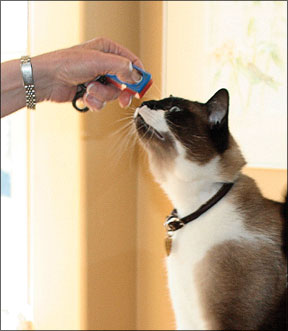Theres a lighthearted saying that goes something like this: “Dogs come when called. Cats take a message and get back to you.” For anyone who has ever shared their home with both canine and feline friends, you know this statement is true! But it doesnt have to be that way. “Your cat is perfectly capable Bev Caldwell 288 of learning to come when called,” says Julia D. Albright, MA, DVM, Resident in Animal Behavior at Cornell Universitys College of Veterinary Medicine. The key, Dr. Albright says, is to use a training method like “clicker training” or “target training” to reward your cat when she performs a certain task. “The clicker [an inexpensive, hand-held device that makes a distinct “clicking” sound] tells a cat what she just did is something her person liked and a treat is coming,” says Dr. Albright. “For instance, if you want your cat to touch her nose with her paw, wait until she does it, then immediately “click” and give her a treat.” Target training involves using your cats natural curiosity to investigate a “target” such as your finger, a pen or a spoon. When your cat engages in a desired behavior (such as touching her nose or coming up to you), “click” and give a food reward. After several trials, she will begin to associate the act with a reward. You can then begin pairing the action with a command such as “touch” or “come.” “Timing is an important component of training cats,” says Dr Albright. “They arent really motivated to perform on cue and they take their time sniffing a treat before eating it, whereas a dog will gobble it up. By the time a cat eats the treat, she no longer associates a treat with the action performed. Thats why I think clicker training is so good for cats – it gives them immediate feedback.” Reasons for Training Your Cat There are times when its important that your cat come to you when called. For example, when: The key to training your cat is to plan ahead. “Dont wait until an emergency happens and you cant find your cat,” cautions Dr. Albright. “For instance, if your indoor-only cat escapes the safety of your home, shes going to be startled, scared and aroused. I suggest taking a towel or blanket outside and scooping her up, if possible.” Dr. Albright point out that using something to cover your cat will decrease her visual stimuli, which is often overwhelming to her. When you pick up your cat, support her weight by placing one hand across her middle and the other hand underneath her. Hold her snuggly, but not too tightly, and close to your body, so she feels safe and secure. In the event you cant locate your cat – whether shes escaped outdoors or is hiding somewhere inside – try banging a spoon against a can of cat food, which often brings them running back inside. “This works for my cats,” notes Dr. Albright, “but it may not be a consistent technique for other cats.” Use Treats to Train Your Cat Training a cat is easier than you think – as long as treats are involved! There are many healthy, tasty treats on the market, so experiment until you find one that your cat just cant resist (those made from real meat or dairy often work well). Next, develop a call, preferably something short and simple. It can be as straightforward as stating her name (“Bella, treat!”). If your cat responds to the sound of a can or bag of food being opened (most cats do), then use this to your advantage by shaking a pouch of treats and calling your cats name. Try using a slightly higher voice as cats are naturally attuned to high-pitched sounds. If more than one person in your household is training your cat, make sure everyone is using the same word or phrase to call your cat over to you. Its important that you reserve this call for training purposes only so as not to confuse your cat. As with all animals, never punish your cat for coming to you. If you get angry and yell at her because she took her time coming over to you, she will be less likely to repeat the behavior in the future. Always reward your cat with a treat, playtime or petting and youll have a happier, better behaved cat. Putting It All Together When you first start training your cat to come to you, its important that you run through the exercise once or twice a day until your cat has mastered “come.” Then you can taper off until youre just running through the drill once a week for practice. With a little patience and practice, your cat can learn this important – and often lifesaving – skill, proving once and for all that dogs arent the only ones who come when called.

Here, Kitty, Kitty!
Training your cat to come to you is easier than you think. And it could make a major difference in an emergency.
An indoor-only cat slips outside;
An emergency such as a fire forces a hasty evacuation;
Youre leaving the house and want to do a “roll call” to ensure all your cats are safe.



